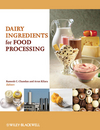Texture on Satiety

The article by Pleunie S. Hogenkampa, Annette Stafleua, Monica Marsa, Jeffrey M. Brunstromd and Cees de Graaf states, "Consumers’ expectations about the satiating capacity of a food may differ markedly across a broad range of food products, but also between foods within one product category. Our objective is to investigate the role of sensory attributes and means of consumption in the expected satiation of dairy products. In three independent experiments we measured the expected satiation of (1) commercially available yogurts and custards (29 adults, age: 26 ± 5 y, BMI: 22.9 ± 2.4 kg/m2); (2) lemon- and meringue-flavored custards with different textures (30 adults, age: 23 ± 4 y, BMI: 22.1 ± 2.1 kg/m2); and (3) chocolate milk and chocolate custard consumed with either a straw or a spoon (30 adults, age: 20 ± 2.2 y, BMI: 21.5 ± 2.2 kg/m2); all based on a single mouthful. Expected satiation was linked to the product's perceived characteristics. We observed an effect of texture (p < 0.0001), but not of flavor on expected satiation (p = 0.98) in Experiment 2; and an effect of texture (p < 0.0001), but not of means of consumption on expected satiation (p = 0.63) in Experiment 3. Thickness was positively correlated with expected satiation in Experiment 1 (r = 0.45; p = <0.001) and Experiment 2 (r = 0.54; p < 0.001). Expected satiation of dairy products increased consistently with increasing thickness; flavor characteristics or means of consumption as tested did not change expected satiation effects."
From the September 6, 2011,Prepared Foods' Daily News.
Looking for a reprint of this article?
From high-res PDFs to custom plaques, order your copy today!






